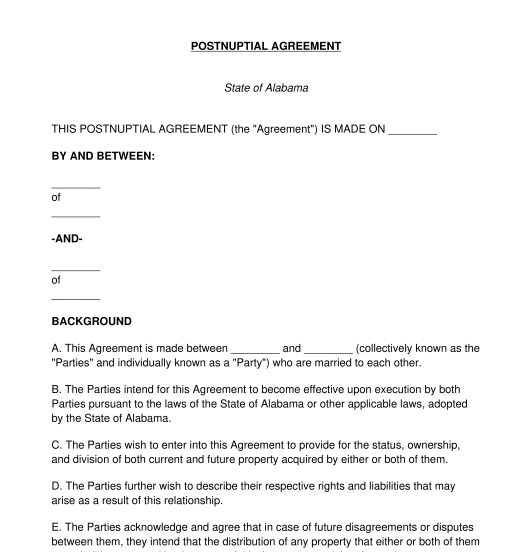 08/31/2025
08/31/2025

Answer a few questions and your document is created automatically.

Your document is ready! You will receive it in Word and PDF formats. You will be able to modify it.

 08/31/2025
08/31/2025
 Word and PDF
Word and PDF
 8 to 11 pages
8 to 11 pages



A Postnuptial Agreement, also known as a Marriage Contract, is a written contract entered into by a married couple while they are committed to one another. Using a Postnuptial Agreement, the spouses are able to outline the financial obligations of both Parties in the marriage and develop a plan of how to divide assets and debt obligations if the marriage ever comes to an end. A Postnuptial Agreement is similar to a Prenuptial Agreement because both documents outline the terms of a potential separation or divorce. However, a Postnuptial Agreement is distinctive because it is created after the couple has already been married. In contrast, a Prenuptial Agreement can only be created before the couple is married. These sorts of contracts are often associated with individuals who have a large amount of assets. However, a Postnuptial Agreement can be used in many different situations, such as the following:
Many people worry that creating a Postnuptial Agreement means that their marriage will end, however, this is not the case. Within most marriages, there is always the chance of separation or divorce. Whether or not a couple creates a postnup, they are in control of the future of their relationship. In many cases, a postnup is just a document used to plan ahead and prepare for the worst. Some couples wish to plan ahead to alleviate future conflict. Being realistic and planning ahead does not mean that a relationship is destined to end. However, if a married couple is currently contemplating separation or divorce, they should not use a Postnuptial Agreement. They should instead use a Divorce Agreement. Creating a Postnuptial Agreement in contemplation of separation could have the effect of invalidating the postnup.
If a couple does not have an agreement in place when they divorce, state laws and courts are left to decide how to divide property, dictate custody, and allocate debt. By creating this postnup, the terms the Parties agree to are used instead of the default guidance of state law. A Postnuptial Agreement, like any contract, can be challenged in court, but the Agreement creates the initial presumption that the Parties agreed to its contents and want to follow those guidelines they agreed on. A thorough and successful Postnuptial Agreement can drastically speed up divorce litigation, or even avoid it altogether in the event of a divorce.
How to use this document
In order to complete a Postnuptial Agreement, the Parties should work together to disclose their assets to each other, decide how they would like to outline their financial obligations, and make arrangements should the marriage end. A Postnuptial Agreement covers several major areas as follows:
A Postnuptial Agreement can be ruled invalid in the following situations that the Parties should be careful to avoid:
The Parties should make every effort to both have a reasonable amount of time to review the completed Agreement prior to signing. After completing the Agreement, the Parties may independently consult attorneys. The Parties may agree to each consult with an attorney prior to executing the document due to the nature of the important and personal rights involved. If desired, there is an option to sign the document in front of their attorneys and have their attorneys complete paperwork acknowledging that they've witnessed the signing of the document. The signatures of both Parties should be witnessed by a third party and that third party should complete their own section on the signature page.
The Parties do not need to file their Agreement anywhere once it is completed. However, signed copies of the document should be kept in a safe and secure location such as a safe, bank safety deposit box, or with an attorney.
If circumstances change, such as one of the Parties loses their job and can no longer fulfill the financial obligations as detailed in the Postnuptial Agreement, or the Parties decide they want to make new arrangements, they do not need to write an entirely new document. By using an Amendment to Agreement document, the Parties can easily add, delete, or rewrite portions of the Agreement as desired or necessary.
Applicable law
Postnuptial Agreements are a matter of state law with different states having different requirements dictating the enforceability of a Postnuptial Agreement.
As of 2017, 27 states (Arizona, Arkansas, California, Connecticut, Delaware, District of Columbia, Florida, Hawaii, Idaho, Illinois, Indiana, Iowa, Kansas, Maine, Montana, Nebraska, Nevada, New Mexico, North Carolina, North Dakota, Oregon, Rhode Island, South Dakota, Texas, Utah, Virginia, and Wisconsin) have signed onto the Uniform Premarital Agreement Act which is also applicable to Postnuptial Agreements. This Act addresses the varying standards regarding these agreements that have lead to varying laws and questionable enforceability as couples move from state to state. This Act dictates that if a Postnuptial Agreement is deemed enforceable in one of the states that has signed on, it will be enforceable in all of the other states that have signed on.
How to modify the template
You fill out a form. The document is created before your eyes as you respond to the questions.
At the end, you receive it in Word and PDF formats. You can modify it and reuse it.
A guide to help you: How to Notarize a Document
Postnuptial Agreement - FREE - Template - Word and PDF
Country: United States